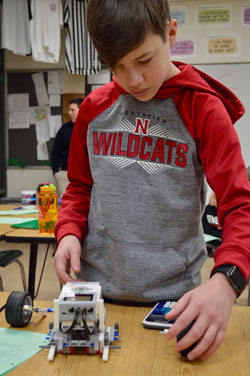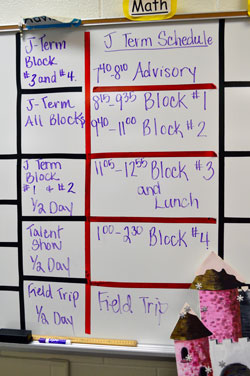Eighth grader Libby Cosby paused during a high-energy credit score game she was playing with three classmates, to share her bottom line of what she planned to take away from a super-short special elective on personal finance.

“I feel so bad for my parents now,” she admitted. “I have three siblings and we always want so much stuff.”
A few classrooms over, Keagan Gessner tried to get a robotic vehicle to operate by figuring out math problems. “This is fun,” said the seventh grader, who later would spend time in mindfulness class and in mythology.
Down the hallway, eighth graders Ava Wagner and Cameron Hicks chatted as they used looms to make hats planned to be given to an area shelter.
And in a standing-room-only situation in the library, students learned about boater safety from Resource Officer Mike Allen.
It was all part of J Term: two weeks of classes dreamed up and taught by teachers.
Besides the economics class, for example, Libby also got to dive into basic physics, learned what goes into a student newspaper, and participated in choir — three other topics not part of her typical school day that sparked her interest.
Teach Your Passion
J Term began as a lunchroom conversation among staff about what a bummer it was to hold exams the week following winter break, Principal Jerry Klekotka recalled.
What if exams could take place before the two weeks off, when what they have learned since fall is fresh in students’ minds? And what if the two weeks following break that mark the end of the first semester were filled with unique, for-credit classes that teachers conceive and that students choose?
Teachers were invited to lead one to three different classes per day, and students chose four classes to attend over the two weeks of J Term.
Teacher Jason Denton led Road Trip 2020, during which students were given a budget and then charged to plan vehicle rental, fuel and food costs and entertainment during a visit to any U.S. national park.
Karen Rivas taught Protecting Planet A, an environmental education class that included a craft project using recycled materials. And Kathy Vogel took on History vs. Hollywood, Random Acts of Kindness and Experience the East Coast.
“We just asked teachers, ‘What are you passionate about, and what would you love to teach your students?’ Klekotka recalled.
J Term class offerings:
• 1990s American history and culture
• Band
• Teenage life
• Advanced fitness
• Boating safety
• Mural magic
• Wearable art
• Basic physics for girls
• Cake decorating
• Improvisation
• American Sign Language
• Interviewing and journalism
• Coding with Scratch
• Road trip 2020
• Team challenge: creative problem solving
• Choir
• World sports games
• Math with robotics
• Mindfulness
• Greek mythology
• JA Junior Achievement
• Bridge building
• Writing about history
• Looming
• Careers in gaming
• Slam poetry
• Crossroads Chronicle student news
• Spanish refresher
• Protecting the planet
• Economics for success
• Sew what
• German
• Board games
• History vs. Hollywood
• Random acts of kindness
• East coast
• Theater

‘Most Unique Two Weeks’
A few offerings incorporated additional help some students needed in particular subjects, and many aligned with new state requirements for increased career awareness standards. J Term wrapped up with an all-day field trip for all students to one of 22 participating area employers.
Klekotka chuckled when a visitor asked about the nine sheets of paper taped together over his desk. It was a spreadsheet that outlined the logistics of the schoolwide career field trip.
He said some parents and businesses donated supplies for J Term, such as fabric and machines from New York-based Wawak Sewing Supplies, and LEGO robot kits from the University of Pennsylvania.
“We have kids now asking ‘Can we run a sewing club after school?’ It’s spawned the interest and created some relationships with companies and people who just want to see kids getting involved.”
Klekotka, who has been in education for 26 years, called J Term “the most unique two weeks of school I’ve ever been involved with.”
Energizing, Exhausting
Klekotka repeatedly gave overwhelming credit for J Term to staff, who largely planned and coordinated it.
“We’ve been really intentional about making it teacher-driven,” he said. “It’s enormously helpful when it comes from their peers, and there had to be a lot of buy-in from staff.”
Administrators and teachers called the process of planning and implementing J Term both energizing and exhausting.
Earth science teacher Theresa Czarnopys taught three units of physics for girls. She joked that she wondered if her feet would ever recover from how often she was on them, moving around her classroom as students worked on projects such as the one she called “the world’s slowest marble race.”
“I have enjoyed it more than I thought I would, and I have been more tired each day than I thought possible,” Czarnopys said.
And rewarding, both for her and for the horizons it expands for students.
A former science teacher to fifth and sixth graders, Czarnopys said she has observed that “in the presence of boys, girls in middle school tend to get very quiet and not speak up much in class. Not so in this class. And that’s been exciting to see.”

Inspiring a Real Newspaper
Language arts teacher Melissa Moens led a Poetry Slam class and Crossroads Chronicle, an experimental student newspaper that was so successful it is planned to kick off for real in February.
“Seeing those kids in their element, inside of my classes and the others, definitely filled my soul and rejuvenated me as a professional,” Moens said. “It’s great to get excited about teaching, but even better when the kids are just as excited to learn.
“I am so thankful J Term allowed all of us this opportunity to both develop and showcase these talents and to learn not only from each other, but about each other on a much deeper level.”
Klekotka said he’s obviously interested to see if having students take exams before winter break will bring an improvement in test scores. He’s also eager to see if the relationships that have been created through J Term inspire kids to connect later learning with what they dove into over the two weeks.
“I thought it was going to be more fluff, to be honest,” he said. “The amount of learning that has gone on in this building in the last two weeks has been tremendous. They can’t get enough of it.”













